Annual Inflation Increased Very Slightly
- Annual Inflation rose from 1.31% in August to 1.37% in September.
- CPI Index rose from 259.918 in August to 260.280 in September.
- Monthly Inflation for August was 0.32%, for September it was 0.14.
- The FED holds steady on Assets and FED Funds Rates.
- Next release November 12th
Annual inflation for the 12 months ending in September was 1.37%
The CPI index itself was up from 259.918 in August to 260.280. Resulting in a monthly inflation rate of 0.14%.
Annual inflation for the 12 months ending in September was up almost imperceptibly from 1.31% to 1.37%.
This is a rebound from an astonishingly low 0.12% back in May.
Since the BLS rounds their numbers they report it as going from 1.3% to 1.4% but the change is even smaller than that.
BLS Commissioner’s Inflation Report:
According to the BLS commissioner’s report, “The Consumer Price Index for All Urban Consumers (CPI-U) increased 0.2 percent in September on a seasonally adjusted basis after rising 0.4 percent in August, the U.S. Bureau of Labor Statistics reported today. Over the last 12 months, the all items index increased 1.4 percent before seasonal adjustment.
The index for used cars and trucks continued to rise sharply and accounted for most of the monthly increase in the seasonally adjusted all items index. The food index was unchanged, with an increase in the food away from home index offsetting a decline in the food at home index. The energy index rose 0.8 percent in September as the index for natural gas increased 4.2 percent.
The index for all items less food and energy rose 0.2 percent in September after larger increases in July and August. The index for used cars and trucks rose 6.7 percent in September, its largest monthly increase since February 1969. The indexes for shelter, new vehicles, and recreation also increased in September. The indexes for motor vehicle insurance, airline fares, and apparel were among those to decline over the month.”
Seasonally Adjusted Inflation Table
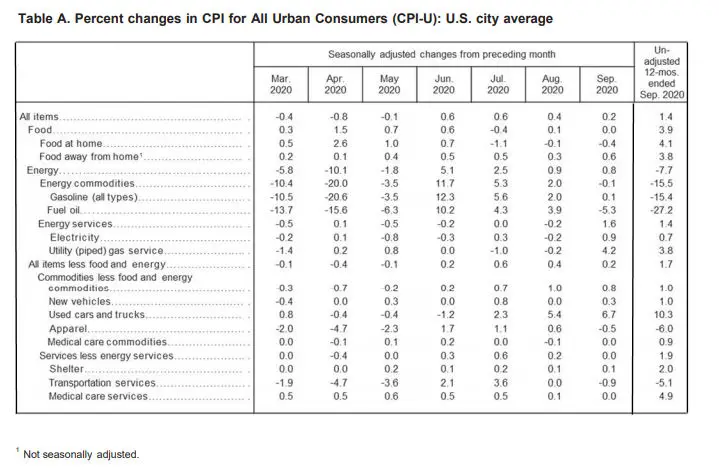 On the table above, we can see that on an unadjusted basis inflation is up 1.4% for the year. We can also see that Energy is up 0.8% in September. But Energy is still down -7.7% for the entire year.
On the table above, we can see that on an unadjusted basis inflation is up 1.4% for the year. We can also see that Energy is up 0.8% in September. But Energy is still down -7.7% for the entire year.
Current Inflation Situation
Inflation bottomed at 0.12% in May before climbing to 1.37% in September.
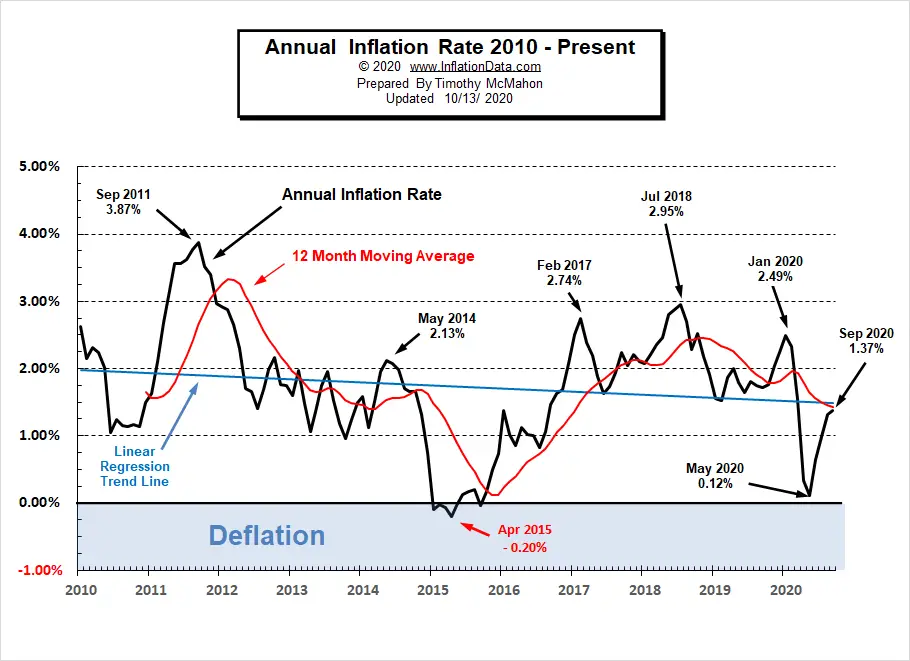 Not Seasonally Adjusted Monthly Inflation Rates
Not Seasonally Adjusted Monthly Inflation Rates
Monthly inflation for June was 0.55% comprising the majority of the annual inflation since March and April’s deflation canceled out most of the rest of the year’s inflation.
| Jan | Feb | Mar | Apr | May | Jun | Jul | Aug | Sep | Oct | Nov | Dec | |
| 2016 | 0.17% | 0.08% | 0.43% | 0.47% | 0.41% | 0.33% | (0.16%) | 0.09% | 0.24% | 0.12% | (0.16%) | 0.03% |
| 2017 | 0.58% | 0.31% | 0.08% | 0.30% | 0.09% | 0.09% | (0.07%) | 0.30% | 0.53% | (0.06%) | 0.002% | (0.06%) |
| 2018 | 0.54% | 0.45% | 0.23% | 0.40% | 0.42% | 0.16% | 0.01% | 0.06% | 0.12% | 0.18% | (0.33%) | (0.32%) |
| 2019 | 0.19% | 0.42% | 0.56% | 0.53% | 0.21% | 0.02% | 0.17% | (0.01%) | 0.08% | 0.23% | (0.05%) | (0.09%) |
| 2020 | 0.39% | 0.27% | (0.22%) | (0.67%) | 0.002% | 0.55% | 0.51% | 0.32% | 0.14% |
See: Monthly Inflation Rate for more information and a complete table of Unadjusted Monthly Rates.
For more information See Annual Inflation.
Federal Reserve Actions
In the following chart, we see the Federal Reserve Total Assets have held relatively steady over the last few months. But back in June, from the 10th through July 8th 2020 the FED shrunk assets and several market commentators panicked assuming the market would crash.
According to the National Bureau of Economic Research (NBER) the U.S. has been in a recession since February (shaded area) after the longest boom in economic history. According to NBER the peak occurred in February 2020. Often their peaks will take a long time before people realize that things are not going well. It is, however, possible that the “recession” will be short-lived if the economy can get back on track especially in light of all the FED money pumping going on.
At first glance, that decrease is worrying for the stock market. But if we look at the breakdown of the FED assets in the chart below we see that the entire decrease comes from “Liquidity Facilities” and not “Securities”. Liquidity facilities typically are near zero so they are simply returning to normal. For more information see Is the FED tightening?
FED Funds Rate
In the chart below, we can see that the FED Funds Rate peaked at 2.42% in April 2019 at that point the FED began fearing that it was holding too tight and the stock market was suffering so it began easing. It leveled off in November at 1.55% where it stayed until February. At that point, COVID tanked the market, and the FED loosened rates to virtually zero (actually 0.05%) five one-hundredths of a percent. In June they moved it up to eight one-hundredths of a percent and then in July, it inched up another one-hundredth of a percent. Then in August, it moved up another one-hundredth of a percent. These increases are essentially symbolic it is still virtually zero.
For more info See NYSE ROC and MIP.
Misery Index
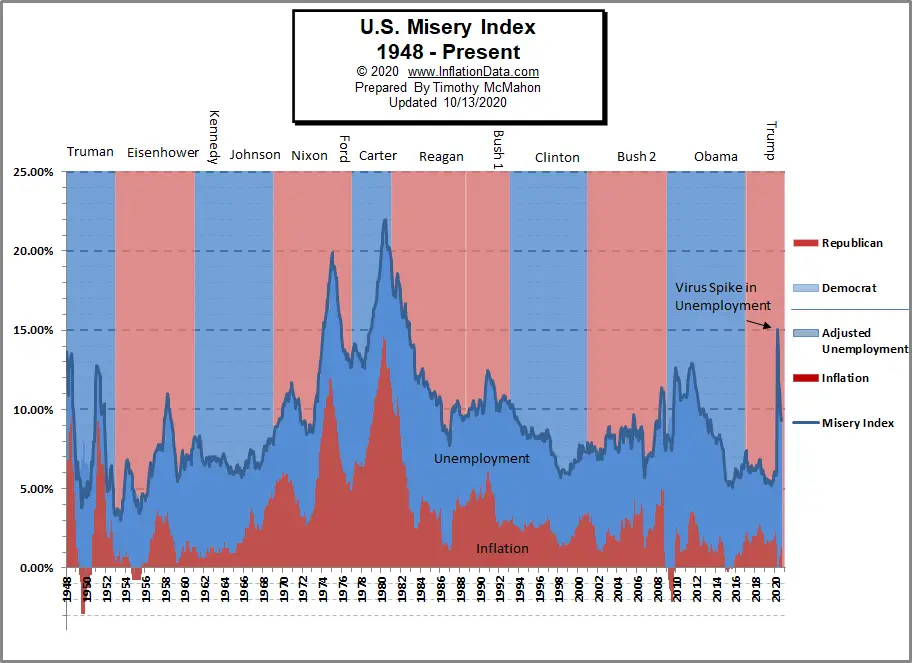 In September 2019, the Misery index was near all-time lows at 5.21%.
In September 2019, the Misery index was near all-time lows at 5.21%.
By March 2020, it had climbed slightly to 5.94%. But in April, due to the COVID-19 shutdown and consequent high unemployment, the Misery Index shot up to 15.03% based on 14.7% unemployment and 0.33% inflation. In May both inflation 0.12% and Unemployment 13.30% fell, resulting in a Misery index of 13.42%. By July unemployment had fallen to 10.2% and inflation had risen slightly to 0.99% resulting in a Misery index of 11.19%. In September, unemployment fell to 7.9% and inflation was virtually unchanged at 1.37% resulting in a misery index of 9.27%… almost a half percent below August.
[Read More…]
NYSE Rate of Change (ROC)©
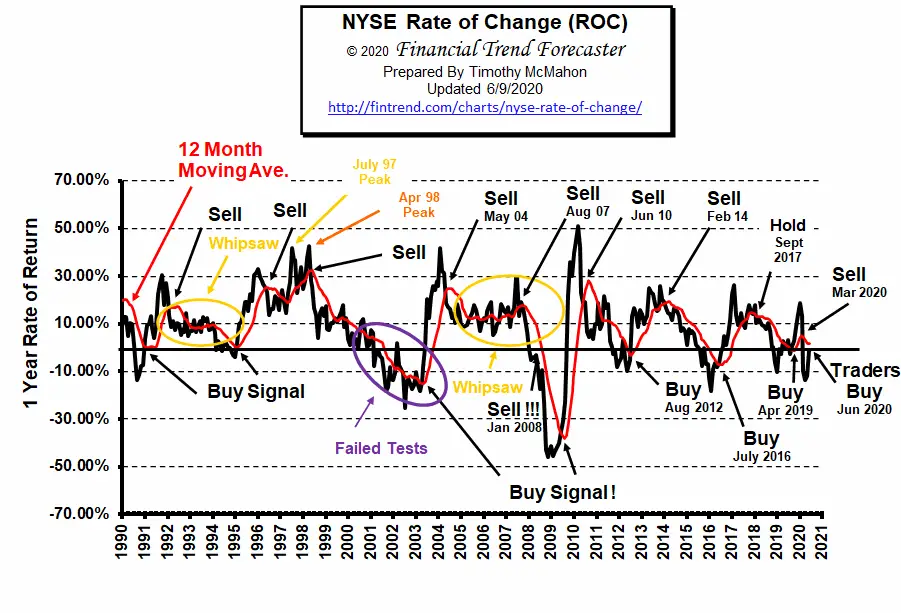
Buy Signal (Whipsaw)
Not surprisingly with all that has happened, 2020 has been a giant rollercoaster ride (aka. whipsaw) for the NYSE.
See the NYSE ROC for more info.
NASDAQ Rate of Change (ROC)©
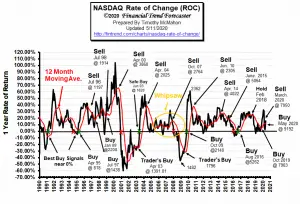
Hold Signal!
The ROC index is ABOVE its moving average. But as we said in the NYSE ROC these are uncertain times and combined with the lofty heights of the NASDAQ caution is warranted. Thus the HOLD Signal.
See NASDAQ ROC for more.
Moore Inflation Predictor (MIP)
This month the MIP is predicting a basically flat month. And is actually projecting relatively little in the way of change through March.
See: Moore Inflation Predictor for more info
Regional Inflation Information
The U.S. Bureau of Labor Statistics also produces regional data. So if you are interested in more localized inflation information you can find it here.
| AL | AK | AR | AZ | CA | CT | CO | DC | DE | FL | GA | GU | HI | IA |
| ID | IL | IN | KS | KY | LA | MA | MD | ME | MI | MN | MO | MS | MT |
| NC | ND | NE | NH | NJ | NM | NV | NY | OH | OK | OR | PA | PR | RI |
| SC | SC | SD | TX | UT | VA | VI | VT | WI | WA | WI | WV |
You Might Also Like:
From InflationData.com
- The Price of Oil Denominated in Bitcoin
- How has Venezuela’s Bitcoin experiment Fared?
- A Guide for Business Owners: How to Prepare Your Organization for Inflation
Read more on UnemploymentData.com.
- September Employment Up 1.25 Million not 661,000
- How to Appear Highly Professional in an Interview
- Need a New Job Fast? Positions You Can Get With Quick Training
- Simple Steps to Planning a Successful Conference
- Is Being a Call Center Agent Right For You?: The Pros and Cons to Consider
From Financial Trend Forecaster
- China Ramps Up U.S. Crude Oil Imports
- Speed and Affordability: Cost of Internet Access Over Time
- New Technologies in the Oil and Gas Industry
- Oil Majors That Bet Big On Renewables
From Elliott Wave University
- Does the Stock Market Really “See” the Future?
- Gold: See What This Fibonacci Ratio Says About the Trend
- Forecasting Markets by Looking at Chart Patterns
- Seeking Certainty in Uncertain Times?
- Emerging Markets and Epidemics
From OptioMoney.com
- Should You Buy a Second Home?
- Learning to Trade from Video Tutorials
- How Saxo Bank Democratizes Trading and InvestmentFive Business Tips to Help Your Company Thrive
- Have Minimal Car Insurance? What to Do in Case of an Accident
- How to Choose a Residential Roofing Contractor
From Your Family Finances
- Pursuing a Wrongful Death Claim After the Death of a Loved One
- More Mistakes to Avoid When Buying Your First Home
- 5 Investment Options for Seniors
- How Families Can Get the Most Out of Roofing Insurance After a Disaster
- 4 Tips for Saving Money on Household Repairs

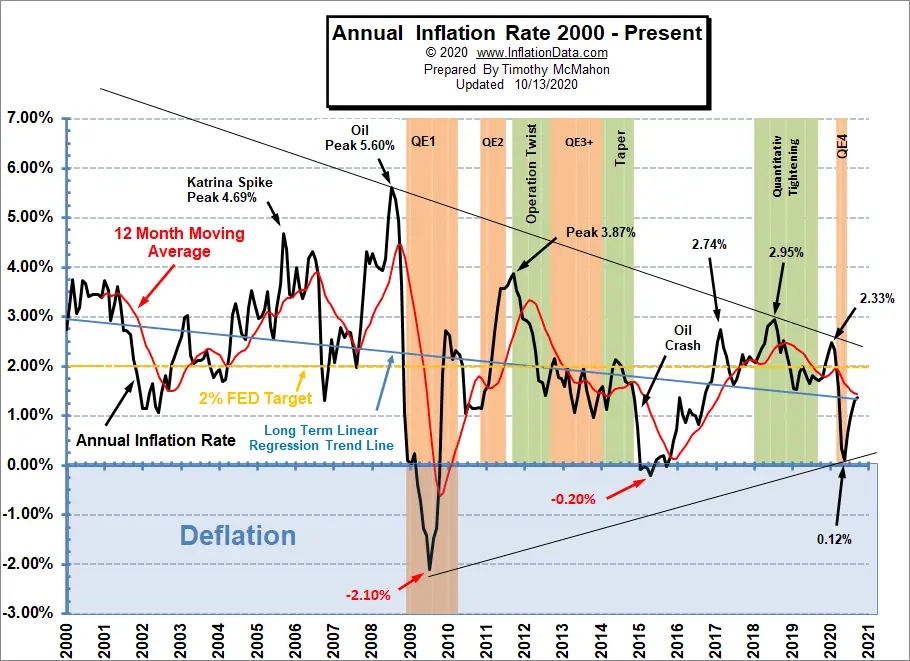
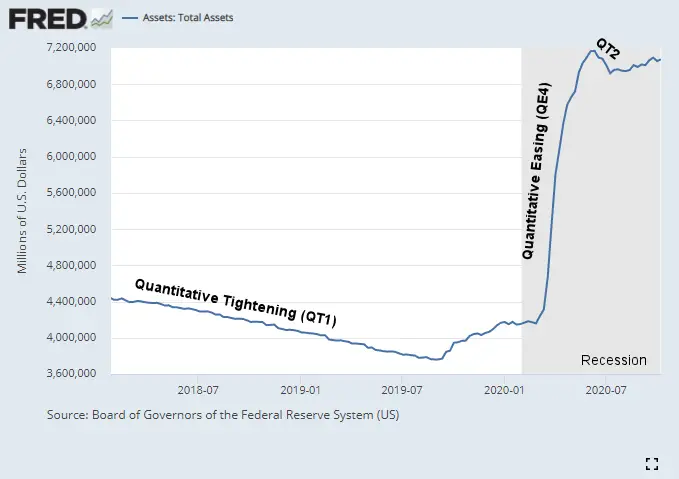
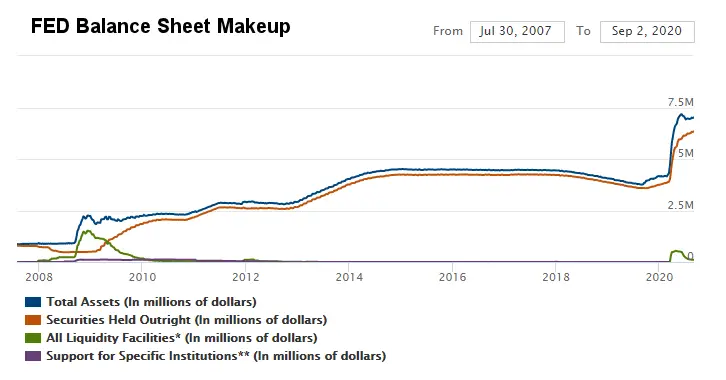
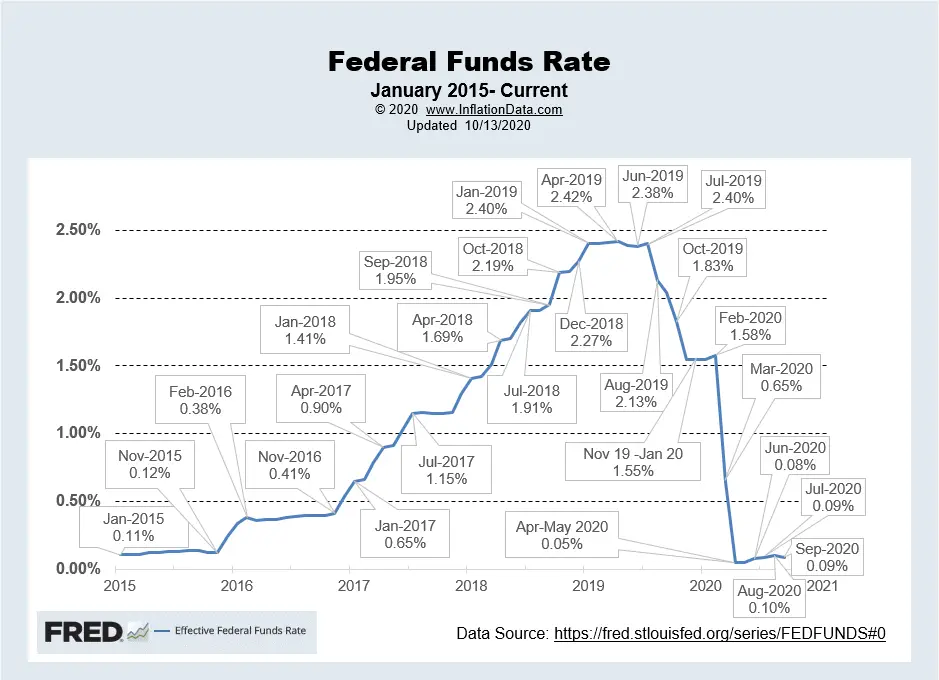

Leave a Reply